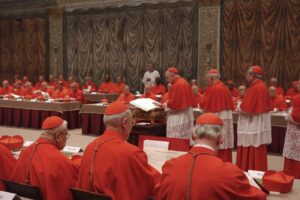So you saw ‘Conclave’ the movie. Here’s what it got right – and wrong – about real-life conclaves
By Canadian Press on April 25, 2025.
Speculation surrounding a conclave to elect a pope is a time-honored tradition. But for the
impending conclave following the
death of Pope Francis, the ranks of armchair Vatican experts have swelled thanks to Hollywood.
“Conclave” the film, a moody
2024 political thriller, introduced many laypeople to the
ancient selection process with its arcane rules and grand ceremony, albeit with a silver screen twist packed full of palace intrigue and surprise.
Though it has its critics, the film treats the gravity of a papal election with respect and accurately portrays many rituals and contemporary problems facing today’s Catholic Church. But Vatican experts warn the
movie doesn’t get everything right.
Here’s a look at what “Conclave” does get right — and wrong — about conclaves. (Spoilers ahead.)
Scenery and aesthetics
The movie excels at re-creating the look and feel of a conclave.
“The film gets a lot right. They tried to reproduce the mise-en-scene of the Vatican accurately,” William Cavanaugh, a Catholic studies professor at DePaul University in Chicago, said in an email. “They show that a lot of the drama is around the preconclave conversations among cardinals.”
It’s not a perfect re-creation, according to the Rev. Thomas Reese, a senior analyst with the Religion News Service and a Vatican expert.
He called the movie’s production values “marvelous,” but noted slight discrepancies in the cardinals’ dress.
“The red in the cardinals’ garments was a deep red, while the reality is more orange. Frankly, I like the Hollywood version better,” Reese, a Jesuit priest who wrote “Inside the Vatican: The Politics and Organization of the Catholic Church,” said in an email.
Papal protocols
The movie aligns with real-life expectations for a quick conclave, said Massimo Faggioli, a historical theology professor at Villanova University in Pennsylvania.
“A long conclave would send the message of a Church divided and possibly on the verge of a schism. The history of the conclaves in the last century is really a story of short conclaves,” he said via email.
Reese pointed out other discrepancies. While the voting process was depicted accurately, he said, the ballots are burned not after each vote, but after each session, which is typically two votes.
Holy plot holes
There are a few particularly egregious errors that, if corrected, would lead to a very different movie.
A key character in the film, the archbishop of Kabul, Afghanistan, arrives just before the conclave with paperwork declaring the late pope had made him a cardinal “in pectore” — “in secret” — allowing him to vote for the next pope.
“The biggest mistake in the movie was the admission of a cardinal in pectore into the conclave,” said Reese. “If the name is not announced publicly by the pope in the presence of the College of Cardinals, he has no right to attend a conclave.”
Cavanaugh agreed and noted that while the movie’s twist about the Kabul archbishop was far-fetched, it does point to a certain truth about conclaves.
“The cardinals do not always know who they’re getting when they elect a pope,” he said. “If the cardinals knew how (Jorge Mario) Bergoglio would be as Pope Francis, many of them wouldn’t have voted for him. Pius IX was elected as a liberal and turned into an archconservative. John XXIII was supposed to be a jolly caretaker pope, and he unleashed Vatican II,”
a series of modernizing reforms.
Another of the movie’s more outlandish storylines involves the dean of the College of Cardinals breaking the seal of the confessional by revealing to another cardinal what a nun confessed to him, said Reese.
“He committed a mortal sin and would be automatically excommunicated. Such an action would be egregiously wrong,” Reese said.
In addition to that, a cardinal paying for votes, as shown in the film, is unheard of in modern times, said Cavanaugh, and the politicking is exaggerated.
And so are the politics.
The movie errs in making cardinals into either liberal or conservative champions, said Kurt Martens, professor of canon law at the Catholic University of America in Washington.
“Those labels don’t help us,” he said because cardinals are very cautious in expressing their opinions and “even someone we think is a liberal cardinal is pretty conservative by secular standards.”
And he added that even in an unusually large conclave like this year’s, the rule requiring the next pope wins at least a two-thirds majority of the vote ensures that “whatever we call extreme” likely won’t get enough votes.
___
Associated Press writers Giovanna Dell’Orto and Nicole Winfield contributed to this report.
___
Associated Press religion coverage receives support through the AP’s
collaboration with The Conversation US, with funding from Lilly Endowment Inc. The AP is solely responsible for this content.
Holly Meyer, The Associated Press
35
-34



